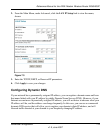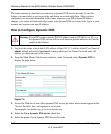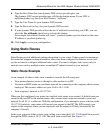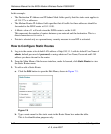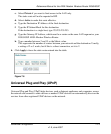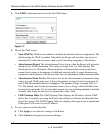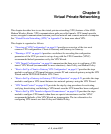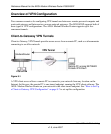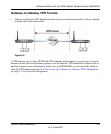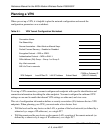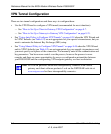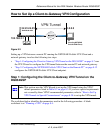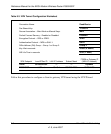
Virtual Private Networking 8-1
v1.0, June 2007
Chapter 8
Virtual Private Networking
This chapter describes how to use the virtual private networking (VPN) features of the ADSL
Modem Wireless Router. VPN communications paths are called tunnels. VPN tunnels provide
secure, encrypted communications between your local network and a remote network or computer.
See “Virtual Private Networking (VPN)” in Appendix C to learn more about VPN.
This chapter is organized as follows:
• “Overview of VPN Configuration” on page 8-2 provides an overview of the two most
common VPN configurations: Client-to-Gateway and Gateway-to-Gateway.
• “Planning a VPN” on page 8-4 provides a worksheet for recording the configuration
parameters of the VPN you want to set up, along with the VPN Committee (VPNC)
recommended default parameters set by the VPN Wizard.
• “VPN Tunnel Configuration” on page 8-6 summarizes the three ways to configure a VPN
tunnel: VPN Wizard (recommended for most situations), Auto Policy, and Manual Policy.
• “How to Set Up a Client-to-Gateway VPN Configuration” on page 8-7 provides the steps
needed to configure a VPN tunnel between a remote PC and a network gateway using the VPN
Wizard and the NETGEAR ProSafe VPN Client.
• “How to Set Up a Gateway-to-Gateway VPN Configuration” on page 8-21 provides the steps
needed to configure a VPN tunnel between two network gateways using the VPN Wizard.
• “VPN Tunnel Control” on page 8-29 provides the step-by-step procedures for activating,
verifying, deactivating, and deleting a VPN tunnel once the VPN tunnel has been configured.
• “How to Set Up VPN Tunnels in Special Circumstances” on page 8-38 provides the steps
needed to configure VPN tunnels when there are special circumstances and the VPNC
recommended defaults of the VPN Wizard are inappropriate. The two alternatives for
configuring VPN tunnels are Auto Policy and Manual Policy.



